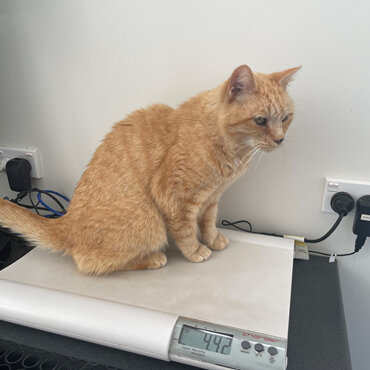Oscar, a 13-year-old cat was brought into the clinic because his owner was concerned about his movement. He was sleeping more and she had noticed that instead of jumping straight onto the couch, he would jump onto the coffee table and then onto the couch, and even then, he was hesitating to jump.
When we examined Oscar, he was found to have pain on the movement of one of his shoulders and didn’t like his spine being pressed on very much. He also had a loss of muscle in his back legs suggesting they weren’t working as well as they used to. This all pointed to arthritis, so a treatment plan was made to manage this. His owner will also closely monitor him for signs of improvement.
90% of cats over the age of 12 have been shown to have arthritis. In this condition, the cartilage of the joint, which normally acts as a cushion is worn away resulting in inflammation, pain and secondary changes around the joint. This may occur due to wear and tear of the joints or secondary to joint injury or abnormalities.
Factors that increase the risk of arthritis include:
- Genetics – certain breeds have an increased risk due to various underlying joint problems. This would include:
- Hip dysplasia (abnormal development of the hip joints) seen especially in Maine Coon cats but is also seen in other breeds
- Patella luxation (dislocation of the kneecap) which has been reported more commonly in Abyssian and Devon Rex cats
- Scottish Folds are particularly prone to severe arthritis affecting multiple joints due to an abnormality of cartilage that occurs in the breed.
- Injury or trauma – for examples fractures, dislocations and other joint injuries. These may cause abnormal joint conformation which can result in secondary arthritis
- Obesity: there is no evidence that this causes arthritis, but it is likely to make an existing condition worse.
Because they don’t often limp like dogs do it can be harder for owners to see the signs as cats just change their behaviours.
Major signs of arthritis in cats associated with arthritis are:
- Reduced mobility
- Reluctance, hesitance or refusal to jump up or down
- Jumping up to lower surfaces than previously
- Jumping up or down less frequently
- Difficulty going up or downstairs
- Stiffness in the legs, especially after sleeping or resting for a while; occasionally there may be obvious lameness
- Difficulty using the litter tray
- Difficulty going through the cat flap.
- Reduced activity
- Increased time spent resting or sleeping
- Not hunting or exploring the outdoor environment as frequently
- Sleeping in different, easier to access sites
- Reduced interaction and playing less with people or other animals.
- Altered grooming
- Reduced frequency of time spent grooming
- Matted and scruffy coat
- Sometimes overgrooming of painful joints
- Overgrown claws due to lack of activity and reduced sharpening of claws.
- Temperament changes
- More irritable or grumpy when handled or stroked
- More irritable or grumpy on contact with other animals
- Spending more time alone
- Avoiding interaction with people and/or animals.
There is no cure for arthritis. Treatment involves a plan involving weight loss if required and management of the pain. The mainstay of treatment involves the use of anti-inflammatory pain relief medication and there are other things that can be done to help as well. This includes:
- Environmental modifications
- Use of soft, comfortable beds placed in easily accessible, quiet, draft-free locations – use of ‘igloo beds’ can make an older cat feel warm and secure
- Provision of a series of ‘steps’ or a ramp to allow cats to access favoured higher sites (e.g. the sofa, a windowsill, the cat flap etc.)
- Make sure the cat flap is very easy to open, and if necessary tie it open so the cat doesn’t need to push through
- Always have a litter tray inside and one that has at least one low side for easy access
- Make sure food and water are easily accessible, at floor level or with steps up to higher levels
- Make sure the cat doesn’t have to go up or downstairs to access food, water, or litter trays
- Spend time grooming and cleaning an arthritic cat as this may be difficult for them
- Overgrown claws need regular cutting
- Diet: this may include a weight loss diet to reduce weight (such as Royal Canin satiety) or a diet designed for arthritis (such as Royal Canin Mobility or Hills J/D)
- Dietary supplements:
- Omega 3 fatty acids (need to be fish based in cats as they don’t have the enzymes to convert plant-based omega 3’s) help reduce inflammation in the body
- Glucosamine and chondroitin – these are the building blocks to cartilage. We recommend the Synoquin range for these as they are made to human pharmaceutical standards.
- Glycosaminoglycan injection: This is a course of injections given once a week for 4 weeks then every 1-3 months. This helps protect the cartilage of the joint.
- Physiotherapy, laser therapy and acupuncture have all been shown to help if the cat will tolerate these.
Dr Nikki Frost BSc BVSc MANZCVS (Medicine of cats).
